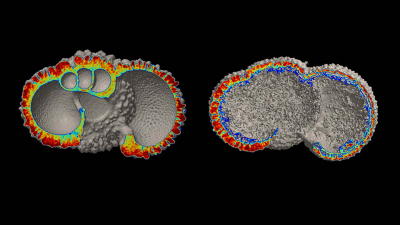- Home
- Discover
- Media Releases
- Media Releases 2022
- carbon distribution
New method reveals carbon distribution of the past in the Southern Ocean

Microorganisms and their fossils store past environmental conditions in their calcareous shells. To decipher them, researchers usually use geochemical analyses. However, ion concentrations in the deep ocean have usually been estimated rather than precisely quantified.
Researchers at MARUM, Japan Agency for Marine-Earth Science and Technology (JAMSTEC), Alfred Wegener Institute, Helmholtz Centre for Polar and Marine Research (AWI), Leibniz Institute for Baltic Sea Research, and Atmospheric and Ocean Research Institute at the University of Tokyo, have developed an X-ray Micro-Computer-Tomography method to assess planktonic foraminiferal shell dissolution as a proxy for paleo-deep seawater, and reconstructed the deep-ocean carbon storage variation in the Pacific Southern Ocean after the Last Glacial Maximum (10 – 22 ka). To do this, they analyzed samples of a sediment core from the Pacific Southern Ocean off the Chilean coast. The technique of X-ray micro-CT scanning provides an evaluation of accurate shell dissolution intensity without the effect of shell geometric characteristics.
They found that the deep-water carbon storage in the Pacific-Southern Ocean decreased in the early part of the last deglaciation (ca, 15 – 19 ka), accompanied by rising atmospheric pCO2. In addition, through comparisons with the data of previous studies, they estimated the distribution and the amount of carbon discharge from the Pacific Southern Ocean. They elucidated that carbon emission from the deep water mass contributed to the increase in global atmospheric pCO2.
“The conventional studies on the ocean carbon cycle in the Southern Ocean have mainly focused on the North-South distribution of carbon. However, since our results have revealed that a significant amount of carbon is also transported in the East-West direction, the evaluation of 3D carbon storage distribution, taking into consideration inter-oceanic deep-water linkages, will be required,” says Dr. Shinya Iwasaki, lead author of the study from MARUM and JAMSTEC.
In the future, this approach, which uses X-ray micro-CT scans of the shell of planktonic foraminifera, will be used in combination with conventional geochemical proxies and help clarify the mechanism of the oceanic carbon cycle.
The study results are from a collaboration between marine geologists and paleontologists from the University of Bremen within the Cluster of Excellence “The Ocean Floor – Earth’s Uncharted Interface,” Japan Agency for Marine-Earth Science and Technology, Alfred Wegener Institute, Helmholtz Centre for Polar and Marine Research, and Leibniz Institute for Baltic Sea Research (IOW).
MARUM produces fundamental scientific knowledge about the role of the ocean and the ocean floor in the total Earth system. The dynamics of the ocean and the ocean floor significantly impact the entire Earth system through the interaction of geological, physical, biological and chemical processes. These influence both the climate and the global carbon cycle, and create unique biological systems. MARUM is committed to fundamental and unbiased research in the interests of society and the marine environment, and in accordance with the Sustainable Development Goals of the United Nations. It publishes its quality-assured scientific data and makes it publicly available. MARUM informs the public about new discoveries in the marine environment and provides practical knowledge through its dialogue with society. MARUM cooperates with commercial and industrial partners in accordance with its goal of protecting the marine environment.
Shinya Iwasaki, Lester Lembke-Jene, Kana Nagashima, Helge W. Arz, Naomi Harada, Katsunori Kimoto, Frank Lamy: Evidence for late-glacial oceanic carbon redistribution and discharge from the Pacific Southern Ocean. Nature Communications 2022. DOI: 10.1038/s41467-022-33753-4
Contact:
Dr. Shinya Iwasaki
MARUM – Center for Marine Environmental Sciences, University of Bremen
Micropaleontology – Paleoceanography
Phone: 0421 218-65958
Email: [Bitte aktivieren Sie Javascript]


